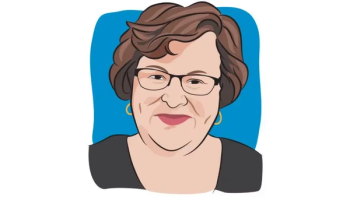
What's Next in Glioblastoma Treatment?
Rimas Lukas discusses the evolving field of glioblastoma multiforme (GBM) treatment.
Researchers are excited about using immunotherapies in glioblastoma multiforme (GBM), says Rimas Lukas, M.D. Experts in the field of GBM are also looking at what the next area of research will be after PD-1 and PD-L1 blockades have been fully investigated. “I think the field of glioblastoma clinical research is at the forefront in the sense that it’s really sort of looking at the next steps,” Lukas said.
Within the field of glioblastoma, what are you most excited about?
CURE recently spoke with Lukas, associate professor of neurology, Director, Medical Neuro-Oncology, at The University of Chicago Medicine, about what those next steps will be, as well as the potential use of IDO inhibitors in the treatment of GBM, and recent studies showing promise in the field.I think as with the rest of oncology the use of immunologic therapies is what really has a substantial proportion of the neuro-oncologists fairly excited. Thinking about specific types of treatment modalities, I think that following in the footsteps of our colleagues in melanoma and other related disorders, things like immunotherapies, specifically PD-1 antibodies, are of particular interest.
For me, right now we’re excited to have recently opened up a trial using PD-1 antibody Opdivo (nivolumab) in newly diagnosed glioblastoma. We’ve had the opportunity to utilize PD-L1 antibody Tecentriq (atezoulizumab) in recurring glioblastoma as well, so I think those are two very exciting things.
Are there specific challenges that come with using immunotherapies in GBM?
Where are we currently with the use of IDO inhibitors?
What are the differences between the use of IDO inhibition compared to the checkpoint blockade approach?
Are there any trials thus far where we've seen promise with immunotherapies in glioblastoma?
The other areas that we are particularly interested in that have a lot of promise are thinking upstream from the PD-1, PD-L1 access, so thinking about IDO and targeting IDO inhibition. I think in the field of glioblastoma clinical research is at the forefront in the sense that it’s really sort of looking at the next steps — what’s going to go after PD-1/PD-L1 blockade once we’ve investigated that fully. I think what many people are substantially interested in is going to be the utilization of not just blocking one checkpoint, but thinking about blocking multiple and what the best combinations are, or using checkpoint blockade in conjunction with either traditional cytotoxic chemotherapies or antiangiogenic therapies. I think in neuro-oncology in particular, we worry a lot about cerebral edema, and when we’re using immunotherapies, that becomes a substantial concern, so our radioeffic endpoints become difficult to interpret. In addition, from a clinical care perspective, patients develop a significant amount of symptoms once they have cerebral edema, and that’s different than I think in many of our other oncologic specialties, where they have to worry about that to a lesser degree. For us, we utilize steroids, often times dexamethasone, to decrease the cerebral edema, which in theory at least, is counter productive to the use of immunotherapies. So, one could imagine whether using antiangiogenic therapies in conjunction with immunotherapy may make reasonable sense. Those are questions that are being actively explored right now and it will be exciting to hear those answers. Right now those are in phase 2 clinical trials. The agent that we’re exploring here is indoximod, that is an oral IDO inhibitor. It appears to be very well tolerated thus far. Hopefully, we’ll get some sort of efficacy signal readout in the relatively near future. IDO is an enzyme which converts tryptophan to kynurenines. Kynurenines help facilitate the immunosuppressive microenvironment and so they’re associated with a higher amount of PD-L1 expression on the tumor cells; they’re associated with a larger amount of Tregs (regulatory T cells) within the tumor itself, and they’re associated with a smaller amount of CD8-positive cells. So from my perspective, they’re the upstream element that plays a role in creating that environment, and so it’s a very attractive target because of that as opposed to your PD-1 or PD-L1 which is dealing with those immune cells or the tumor itself. It’s sort of an upstream and downstream type of a picture. I think that one of the most interesting and I think complicated stories right now is the EGFRvIII vaccine, the Rintega (rindopepimut) vaccine, an agent which we’ve participated in a number of clinical trials with here. It’s a very well tolerated agent, so it takes the external domain tumor-specific epitope, tags it on to keyhole limpet hemocyanin (KLH), something that ramps up the immune activity as GM-CSF, which further stimulates immune activity and is administered intradermally. The immune system then reads it outside the nervous system and says, ‘ah ha, this is something similar to what we have going on inside the nervous system within the tumor itself,’ and then ideally allows the immune system to do its job where it needs to.
Is there an understanding as to how or if brain cancer is immunogenic?
It demonstrated improvement in overall survival (OS) in a randomized phase 2 study called REACT for recurrent glioblastoma, however, in the preliminary analyses of the randomized phase 3, act 4 clinical trial for newly diagnosed glioblastoma, it did not demonstrate benefit in survival, so it speaks to the idea that timing of the agent may play a role in efficacy. It also speaks to the idea that the second agent we’re using it with — so in the act 4 study temozolimibe and in the REACT study, Avastin (bevacizumab) — may play a role in potential efficacy. I think there’s still a substantial amount that we’ll learn about from that agent and I think from my perspective, that’s the story that’s the furthest developed. I think that thus far with respect to other immunotherapies, checkpoint inhibitors, etc., we have data that they appear to be safe and they have a unique set of toxicities that most neuro-oncologists hadn’t been used to before. We’re used to our cytotoxic chemotherapy toxicities, we’re used to our antiangiogenic agent toxicities, and now we’re having to get used to our immunotherapy toxicities, so I think it’s a learning curve for all of us, which is interesting. It falls into this sort of moderate mutational load type of a picture. I think we have a clear understanding that there is a locally suppressed immune environment and there’s also a globally suppressed immune environment and so if we look at absolute lymphocyte counts in these patients at time of diagnosis prior to any intervention, we’ll see that they have low absolute lymphocyte counts (ALCs) and from a clinician’s perspective it’s interesting because we don’t really see patients coming to us with opportunistic infections despite having these low ALCs.
What do you think is the best challenge in glioblastoma?
We know there is an alteration in the way the immune system works. I think that there are patients who appear to have worsening of their tumor initially, so they’re having these radiographic pseudo-progressions and then they have a redirection of that and it seems to be associated with a sustained response. I think it’s too early to be able to say anything definitively at this point in time, but I think that the use of immunotherapies is very rational in this patient population and I think it’s something that is well worth exploring. I think the biggest challenge is the short overall survival. I think that for us going after improving overall survival and trying to improve the tail end of the curve when we’re thinking about people who have prolonged sustained responses that’s what most of us are chasing after. At the same time we are trying to maintain a good or reasonable quality of life while doing so. I think the reasonable quality of life element we’re able to accomplish, I think it’s just that the overall survival improvement is really where the work needs to be done, so there’s a gargantuan need for these type of novel therapies.




